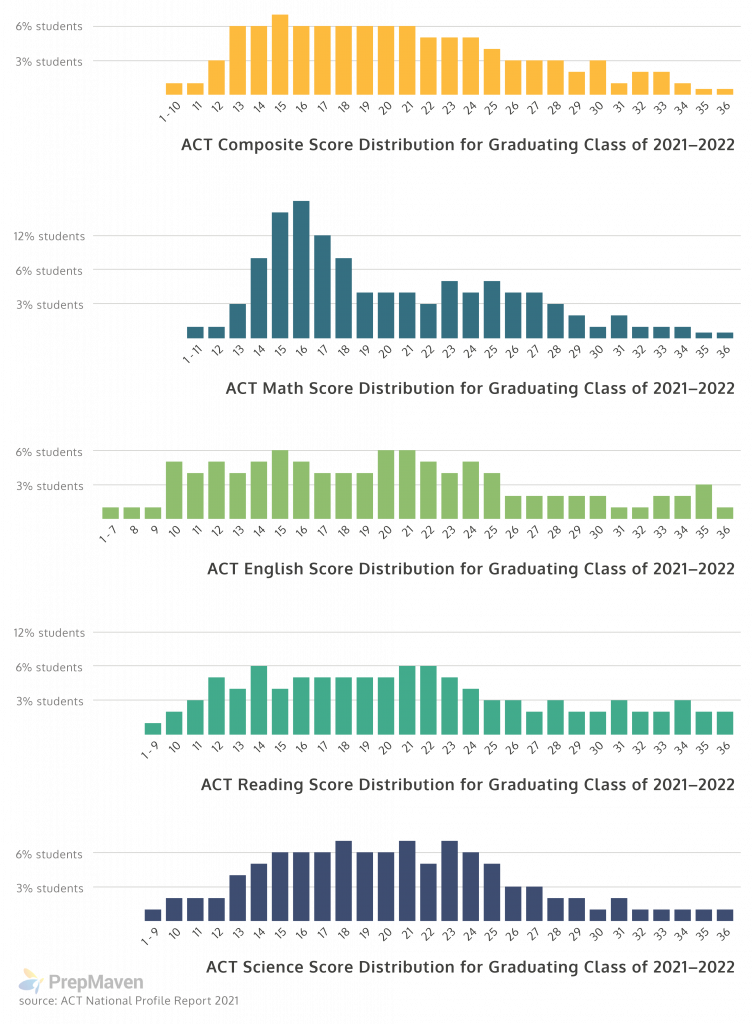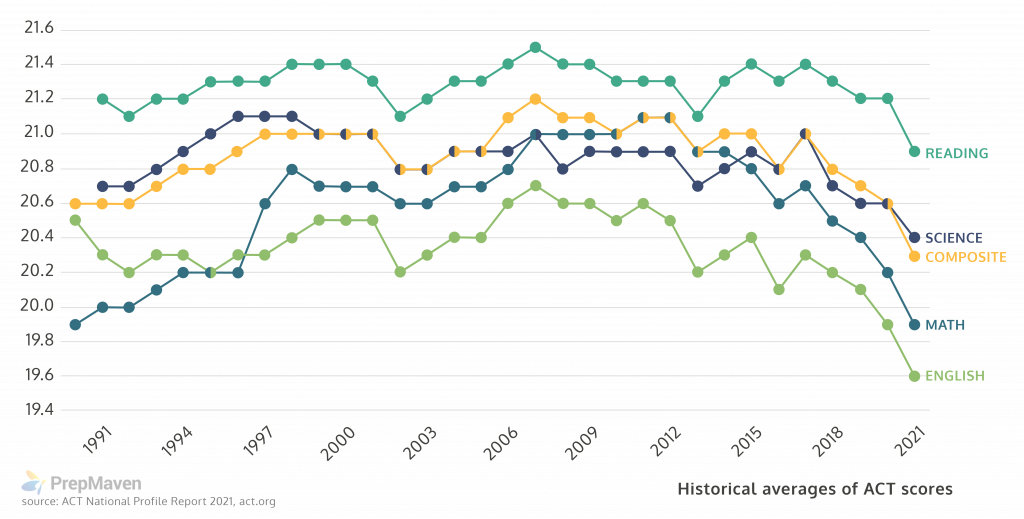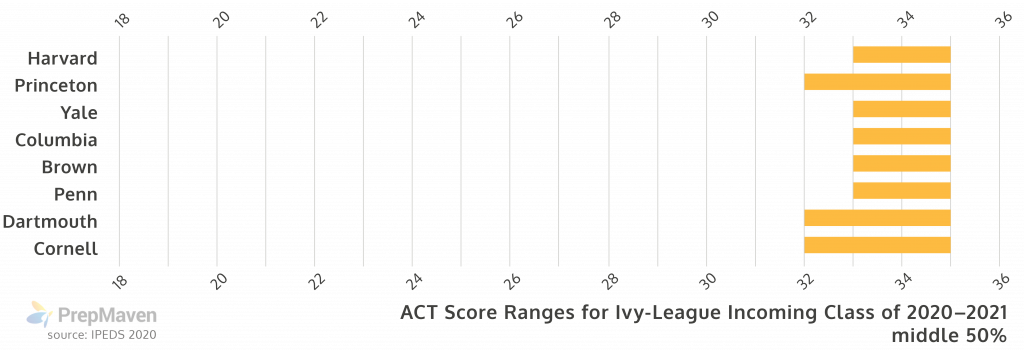
Every day, students and families ask us to help them understand ACT scores.
In this post, we’ll do a deep dive into the data to answer all of your questions about average ACT scores.
We’ll answer what’s the average ACT score in the US for this year—but also the average ACT score for the Ivy League, the average ACT score at the best universities and liberal arts colleges in the US, and average ACT score at the top public universities.
We’ll find out how common is a perfect score, which states have the highest average ACT scores, and how ACT scores have changed over time.
Finally, we’ll show how to use this data to help navigate the college admissions process more successfully.
We did exhaustive original research to get the latest data that’s not easily available, from dozens of separate sources (including working directly with admissions offices at universities throughout the country). As Princeton grads who love data, we did all the hard work so you don’t have to!
In this post we’ll cover:

Average ACT scores can be a powerful tool in crafting your admissions strategy.
They’re obviously not the entirety of a college application— all the other elements matter , especially your high school academic record.
For example, though, imagine you had a 29 composite score for your ACT. That’s a great score! It’s the 90th percentile for the US, which means your score would be higher than 90% of other students!
However, if you had a 29 ACT score, that would be a very low score at the nation’s top schools:

Checking out the distribution of ACT scores at the top schools, we see that only about 5% of students (a few dozen students) at these top schools had scores in the 20s . . . and we can assume that those people had something REALLY amazing about them—they are probably Olympic athletes or published scientists or students who fought exceptional circumstances (refugees from war zones, etc).
We can see that at these top schools, roughly 95% of students scored in the 30s in English, 85% scored in the 30s for Math, and 95% of students have composite ACT scores in the 30s.
What does this mean for students hoping to apply to the Ivy League and other top schools?

Uncovering the data for the distribution of ACT scores at colleges and universities throughout the US allows us to get a better sense of an applicant’s chances at a given school. A good general rule is that your ACT score should fall within the 25th and 75th percentile at your target schools.
(Percentile means the percentage of students compared to whom your score would be higher. So 15th percentile means that your score would be higher than that of 15% of other students, but that 85% of students would have a higher score than yours. Or 80th percentile means that you scored higher than 80% of other students. We use percentiles to talk about where an individual student falls within a given distribution.)
It’s okay to apply to a few schools where your ACT score would be below the 25th percentile, but those are “reach” schools for you, and you should expect that your chances of admission are low at those schools, especially if you don’t have exceptional grades, extracurriculars, and essays.
On the other hand, schools where your ACT scores are above the 75th percentile—assuming your grades are okay—are probably “safe” schools where you are more likely to be admitted.
We also like for “safety” schools to have an acceptance rate higher than about 30%, since even for an amazing applicant there’s a significant element of chance at the most competitive schools.

In this way, you can use your ACT scores to craft a balanced college application list, with at least two safety schools, two target schools, and two reach schools.
(By the end of your junior year, it’s hard to change your GPA or your extracurriculars—but it’s definitely possible to improve your ACT scores and your college essays. Want to boost your ACT scores so that they’ll be within range for your dream school? Check out our one-on-one ACT tutoring .)
A note about test-optional: although many schools have temporarily implemented test-optional policies to adapt to the Covid-19 pandemic, we can see from the data that at the top schools the vast majority of admitted students did submit ACT or SAT scores. Looking at detailed information from the admissions offices, ACT and SAT scores will still be used for admissions purposes if they’re submitted, so good scores can still be part of a compelling application. It’s also unclear how long the test-optional policies will last, so we still advise students to take the ACT and/or SAT and try to get the best scores possible.
It depends! We answer this question in more detail in another post . But generally speaking, a “good” ACT score for you will be in the range between the 25th and 75th percentiles for your target schools, and it should be above the 75th percentile for your safety schools.
Your score can be below the 25th percentile for your reach schools, but know that they’re exactly that—a reach—and your chances of admittance are low, especially if you don’t have some other aspect in which you’re exceptional (or at least above-average for that particular school).
Read on below to see if your score is above-average for the US or for your state!
What’s the average ACT score in the US for 2022? The short answer is 19.9 for English, 20.2 for Math, 21.1 for Reading, 20.5 for Science, and 20.6 for the composite ACT.
But we have a lot more useful data than just these numbers!
For starters, we learn a lot more when we look at a histogram showing the distribution of scores on a national level.
Below are the score distributions for all students taking the ACT during the the 2021–2022 reporting year:

Each bar on the graphs represents the percentage of students who earned that particular score in the 2021 testing year. For example, the most common score on the Math section of the ACT in 2021 was a 16, and approximately 155,440 students across the US earned this score.
Looking at the shape of the graphs, we see that more students across the US score very highly in English and Reading than in Math or Science.
If we look at how many students scored very highly (in the 34–36 range), we see that 78,299 students scored in this range for English and 87,571 students for Reading, compared to 30,005 students for Math and 37,056 students for Science—so very high scores are more than twice as common for English and Reading than for Math and Science.
In total, 31,913 students in 2021 had composite scores in the 34–36 range. Broadening slightly, we learn that 123,183 students in 2021 had composite ACT scores in the 30s.
As we’ll see below, nearly all of the students at the Ivy League and other top-tier schools came from among this group of 123,183 students (or the analogous group of high SAT scorers).

In general, English and Reading scores are more spread out—more students with quite low or quite high scores—compared to Math and Science scores. (For anyone wanting the stats, the standard deviation is 7.2 for English, 5.7 for Math, 7.0 for Reading, and 5.9 for Science.)
Digging into the data, we can learn that in 2021, 4,055 students across the US got a perfect 36 composite ACT score. (Note that, because the ACT composite score is an average of all four sections, it’s possible to get a “perfect” composite score while scoring 35 on two of the sections.)
Interestingly, there’s been an increase in the number of students getting perfect scores over the past two and a half decades, especially since 2012. Check out this graph showing the percentage of students who got a perfect composite score of 36 on the ACT between the years 1996 and 2021:

These are still very low numbers—in 2021, only 4,055 students taking the ACT earned a perfect score. However, the percentage of students getting a 36 on the ACT has gone from less than 0.01% to 0.34% in 2020! (There’s a small dip for 2021, which we can likely attribute to the Covid-19 pandemic.)
The makers of the ACT have assured us that this isn’t because the test is getting easier!
Rather, our hypothesis is that the rise in students getting perfect scores is because more high-achieving SAT “superstars” are now also taking the ACT, whereas before they would have only taken the SAT.
(Wondering about the difference between the SAT and the ACT, and why it makes sense to take both? Check out our discussion of whether to take the SAT or the ACT .
In fact, the average ACT score has been pretty consistent between 1990 (when the test format and scoring scale was changed) and 2017. Reading has always had the highest average nationally, while since 1997 English has had the lowest average nationally.

If anything, the average ACT scores have fallen since 2017, and took an especially sharp drop in the past two years (since 2020). We can assume that the drop from 2020 has likely been due to the effects of the Covid-19 pandemic.
Wondering which schools in the US have the highest ACT scores? Number one is not Harvard or Stanford! Here’s the scoop.
We focused on the middle 50% of students at each school—the range between the 25th percentile and the 75th percentile—because that gives us a much clearer picture of the distribution of scores than a single number. Using this 25/75 range, we get a good sense of the “average” student at one of these schools.
Here are the schools with the highest composite ACT scores in the US:

Students at CalTech have the highest ACT scores in the country! At least 25% of students at CalTech scored a 35 on the ACT. Impressive!

The schools with the highest ACT scores tend to be STEM-focused schools, since fewer students nationwide earn a 36 in Math and Science.
We can also look at the breakdown for the individual ACT Math and English sections. (Data for the Reading and Science sections isn’t commonly reported, so we’ve been unable to include it here.)
Here’s a visualization of the schools with the highest ACT English scores:

The schools with the highest ACT English scores are CalTech, MIT, Duke, UChicago, and Harvard.
We can see that the English scores at the top schools are a little higher than the Math scores.
This makes sense in light of the distribution of scores nationally—significantly fewer students have top scores in Math and Science compared to English and Reading.
Here’s a visualization of the schools with the highest ACT Math scores:

The school with the highest ACT Math scores is CalTech, followed by MIT and Harvey Mudd, then Carnegie Mellon, Rice, Johns Hopkins, Duke, and Bowdoin.
Unsurprisingly, these are mostly STEM-focused schools!
What percentage of students at these top schools have a perfect 36?
We can’t tell this exactly from the published data, but for some schools we know that at least 25% of the students have a perfect 36: Caltech, MIT, Rice, and Johns Hopkins.
We also know that at the top schools roughly 90% of students have scores in the 30s.
This is perhaps a good reminder that a great ACT score alone doesn’t guarantee admission to the most competitive schools, since (unfortunately) it’s not particularly exceptional at those schools.
Check out the average ACT scores at your dream school with this list of scores of 499 US colleges and universities:
What’s the Ivy League, and what is the average ACT score for the Ivy League schools?

Technically the Ivy League is actually an athletic league!
The term was coined in the 1930s and made official in 1954, when Harvard, Yale, Princeton, Columbia, Penn, Brown, Dartmouth, and Cornell formed an agreement to balance competition in football with high academic standards.
From the 1950s, these eight schools organized athletic competitions in many sports, and they gradually also added committees to develop intercollegiate policies for admissions and financial aid.
The Ivy League represents some of the oldest and most prestigious schools in the country. Here’s the complete list:
Here is the range between the 25th percentile and the 75th percentile for composite ACT scores at the eight Ivy League schools:

We can see that the range is very consistent across the Ivies and very narrow, between 32/33 and 35. We get a fuller picture when we look at the ranges for the individual sections:

Splitting apart the section scores reveals that most students at the Ivies have a perfect or near-perfect score for English.
At least a quarter of the students in the Ivy League scored a perfect 36 on the English section, and 75% of them scored at least a 34. (At Harvard, 75% of students scored either a 35 or a 36.)
The ranges are a bit broader when it comes to the Math section, which is more difficult on the ACT.
At least 75% of students at all of the Ivies still scored in the 30s, but the ranges are definitely lower than for English.
(Data for the Reading and Science sections isn’t commonly reported, so we haven’t included them here. Looking at the national data, we can extrapolate that ranges for Reading are similar to English, and ranges for Science are similar to Math.)
The average ACT scores for the entire Ivy League are 31–35 for Math, 34–36 for English, and 33–35 for the composite ACT.
That means that if your dream is to attend an Ivy-League school, you should work to get your ACT scores into the 30s, ideally in the super-high 34–36 range, especially for English and Reading.

We can take a look at the numbers here:

Here, we show the range between the 25th percentile and the 75th percentile at the top 20 US universities for ACT composite scores:

We can also zoom in a bit more and look at the section scores for English and Math:

Looking at the graphs, we can see that average ACT scores are consistently very high at all of the top 20 universities. The middle 50% of students scored in the 30s for Math, English, and the composite ACT at all of these top-tier schools.
For example, at Harvard, a 35 for English would be in the 25th percentile, so 75% of students have above a 35! A 31 Math would be in the 25th percentile, so 75% of students have above a 31 Math.

A perfect 36 is very common at CalTech, MIT, Rice, and Johns Hopkins, where at least 25% of students have a 36 composite score on the ACT.
More students at these schools have perfect 36s than at Harvard, Yale, and Princeton because it’s less common to earn a 36 on the Math and Science sections of the ACT.
At least 25% of students at most of these top schools have a perfect 36 in English, but only at CalTech and MIT do at least 25% of students have a perfect 36 in Math.
So when it comes to the schools with the highest overall ACT scores, it’s the STEM-focused schools that come out on top!
We can dig into the data a little more to see the distribution of scores at each of these top-tier schools.
Generally speaking, about 95% of students at the top 20 universities scored in the 30s on the ACT. (This drops to about 85% of students for schools at the bottom of the top-20 list like Notre Dame.)

The graphs show us that there were only a handful of students in each class year with Math or English scores lower than 30. We can assume that these students were exceptional in other ways!

As a whole, the average ACT scores for the top 20 universities in the US are 34–36 for English, 31–35 for Math, and 33–35 for composite ACT scores.
This means that if you hope to apply to the top-tier universities in the US, you should aim for ACT scores in the 30s, ideally in the 34–36 range.

Check out the numbers here:

As we can see, the average ACT scores at the top liberal arts colleges in the US are quite high.
In fact, average ACT scores at Pomona, Williams, Harvey Mudd, Haverford, Hamilton, Washington & Lee, and Vassar are comparable to the scores at the Ivy League and other top-tier universities.
As a whole, the average ACT scores for the top 30 liberal arts colleges in the US are 31–35 for English, 27–32 for Math, and 30–33 for composite ACT scores.
Broadly speaking, if you’re hoping to attend a top-tier liberals arts college, you want your total ACT score to be in the 30s, though it’s okay if your Math or Science section score is in the high 20s.

Check out the numbers here:

In fact, back in 1985 a Yale Admissions officer coined the phrase “public Ivies” to describe the best of the public universities, in his book Public Ivies: A Guide to America’s Best Public Undergraduate Colleges and Universities.
A more recent list was published by Howard and Matthew Greene’s 2001 book The Public Ivies: America’s Flagship Public Universities. According to this book, the top 30 public universities in the US are the following:
We expanded this list of the “public Ivies” to show you the average ACT scores at the top 50 public universities in the US, ordered according to the US News and World Report rankings . A dot indicates schools on the list of “public Ivies”:

We can notice that, as with the top-tier universities and liberal arts colleges, the average ACT scores at most top public universities are higher for Math than for English, likely because the top students study hard to raise their ACT Math scores, but it’s harder to raise ACT English scores.
We can also notice a few schools with especially high ACT Math scores compared to their ACT English, like the University of Illinois, the University of Wisconsin (Madison), and Purdue. These happen to be universities with particularly strong programs in math and engineering.
At Indiana University and University of Iowa, on the other hand, the average ACT English scores are higher than the average ACT Math scores. This might reflect the fact that Indiana University is one of the top schools in the country for music, while the University of Iowa is well-known for its writing programs.
As a whole, the average ACT scores for the 50 best public universities in the US are 25–33 for English, 25–31 for Math, and 27–32 for composite ACT scores.
Roughly speaking, this means that if you hope to attend one of the top large public universities, you should aim for a composite ACT score in the 30s or high 20s.
*Note that through 2025, the University of California schools aren’t accepting ACT or SAT scores. (They’re not just test-optional, they’re test-blind, so they won’t look at scores if submitted.) However, as we discussed above, looking at historic ACT data can still give a good idea about the competitiveness of the schools and your general chances of admission.

Check out the numbers here:

The schools of the Big Ten conference are known for combining academic achievement with athletic success. Most are public universities, but Northwestern is a top-tier private university.
We can see that the average ACT scores at the Big Ten universities are high:

As a whole, the average ACT scores for the Big Ten conference are 25–32 for English, 24–30 for Math, and 25–31 for composite ACT scores.
This means that, broadly speaking, if you want to go to a Big Ten university, you’ll want your composite ACT score to be in the 30s or high 20s.

Check out the numbers here:

As a whole, the average ACT scores for the top 50 colleges and universities in the US are 32–35 for English, 30–34 for Math, and 32–35 for composite ACT scores.
This means that a good rule of thumb for anyone who wants to apply to a top-50 school is to aim for an ACT score in the 30s.

Check out the numbers here:

This map shows the average total ACT scores by state. At first glance, it looks like the Northeast states and California are at the top:

But before we wonder what those Northeastern states are doing right. . . it’s actually a bit more complicated!
Some states have very low participation rates for the ACT, meaning that not very many students take the test. (Note that participation rates have been affected in recent years by the Covid-19 pandemic, and some states that normally have nearly 100% participation are down.)
So in Massachusetts and Connecticut, where the scores are quite high, only 7% and 9% of students in the state actually took the test. Participation numbers are similarly low for the entire Northeast, which the SAT has traditionally dominated. We can assume that the students who go out of their way to take the ACT in these states tend to be more prepared than average, skewing the scores higher.
If we first map the participation rates across the US, it looks like this:

We can see that the ACT is most commonly used in the Midwest and in the South. The states with the highest participation rates are those where all high school students are required to take the SAT, like Nevada.
With that in mind, let’s look again at the average ACT scores in each states—but this time, let’s only show states with a participation rate greater than 10%:

Without those SAT-dominant states, the map looks quite different!
Now the highest-scoring states are the District of Columbia, with an average ACT score of 25.6 and a participation rate of 19%; Illinois, with an average ACT score of 25.2 and a participation rate of 19%; and New Jersey, with an average ACT score of 25.1 and a participation rate of 12%.
All of these participation rates are still pretty low, though. If we look at only the states where 30% or more of graduating seniors took the ACT, our map looks like this:

Of these high-participation states, the winners are Minnesota (average 21.6 ACT), South Dakota (average 21.6 ACT), and Iowa (21.6). All of these are higher than, but much closer to, the national average of 20.6.

Check out the average score for your state here:

Not sure how to study more effectively, struggling with certain concepts, or just generally want some help?
We’ve helped thousands of students boost their ACT scores with our one-on-one ACT tutoring . We’re happy to chat about your particular challenges .
You also might want to check out the SAT and see which test is a better fit for your strengths. You can read our comparison of the two tests and take a look at our deep dive into average SAT score data .
Once you’ve studied, it’s time to take the test!
Ideally, be strategic about when you schedule your tests.
Many students take the ACT multiple times, with between two to four times being the most common. In between each test date, learn from your experience with the previous test to study more effectively and target problem areas.
Once you know your final ACT score, revise your college list to make sure you have at least two “target” schools (where you’re in the middle 50%) and at least two “safety” schools (where you’re in the top 25%).
Make sure to pay attention to the other components of your college applications, too—your GPA, college essays, extracurriculars, letters of recommendation, and interview matter too.
Submit your applications your senior year of high school and relax!
Here’s what you’ll get with this handy resource:


Emily
Emily graduated summa cum laude from Princeton University and holds an MA from the University of Notre Dame. She was a National Merit Scholar and has won numerous academic prizes and fellowships. A veteran of the publishing industry, she has helped professors at Harvard, Yale, and Princeton revise their books and articles. Over the last decade, Emily has successfully mentored hundreds of students in all aspects of the college admissions process, including the SAT, ACT, and college application essay.